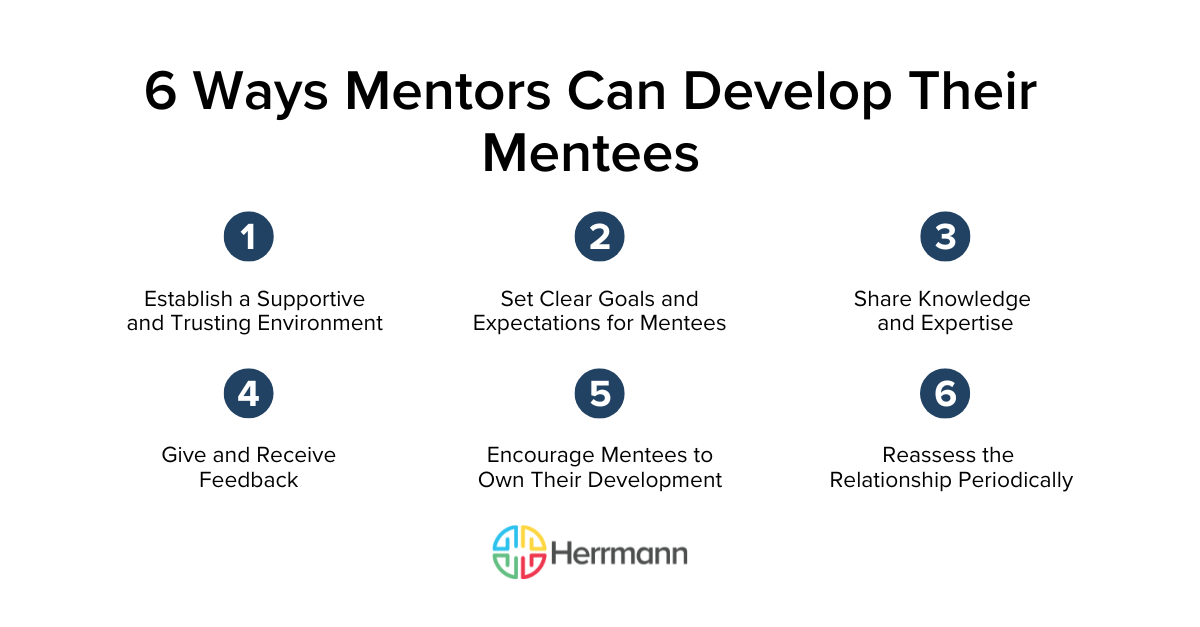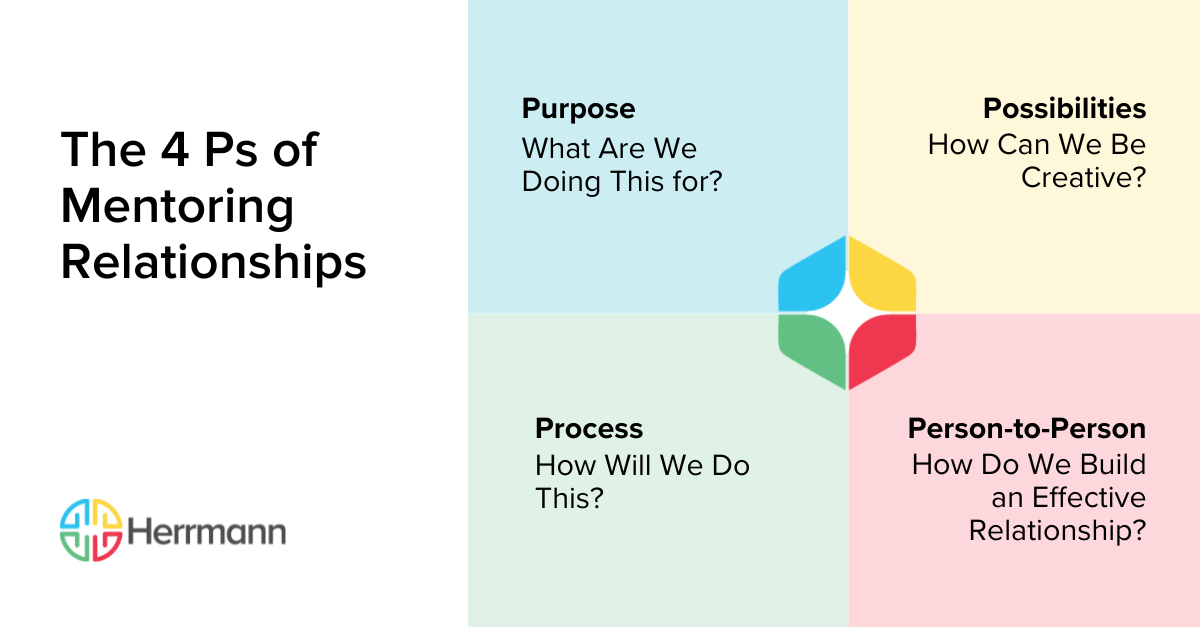Effective leaders deliver impact in ways that can last long beyond their tenure with a team or organization. Mentoring relationships are one of the most powerful ways for these leaders to develop the next generation of talent, improve business outcomes, and leave a proud legacy.
Many organizations have formal mentoring programs, including over 90% of Fortune 500 companies, according to MentorcliQ. The benefits of mentoring are clear: 9 in 10 workers with mentors are happy in their jobs, which is a powerful retention tool in this age of quiet quitting.
Learn more about what goes into mentoring relationships, how to start a formal mentorship program in your organization, and how Whole Brain® Thinking enhances the mentor-mentee dynamic.
What Is a Mentoring Relationship?
A mentoring relationship is a partnership between a more experienced individual (the mentor) and a less experienced individual (the mentee). It involves transferring knowledge, skills, and guidance to support the mentee's growth and development.
Mentor relationships can be formed organically, or they can be part of formal programs run by employers or contracted outside organizations. These relationships pair two people, generally with different experience levels and expertise. While mentors and mentees can be co-workers, they don’t have to be.
Traditionally, mentoring involves older, more senior leaders helping younger, more junior employees, other approaches exist. Peer mentoring involves two people of similar levels and experience working together to help each other’s career development. Reverse mentoring, meanwhile, is when a more senior employee receives counsel from a younger or less-experienced colleague.
Note that while mentors can be managers, coaches, or sponsors, each of these professional roles are distinct. Managers directly oversee an employee’s work, while mentors don’t. Coaches often focus on specific tasks or role-specific growth, whereas mentors offer advice that’s often more high-level. And while mentors are encouraging and supportive, they don’t necessarily have the power to influence the mentee’s career prospects in the way sponsors do.
Roles and Responsibilities of Mentors and Mentees
Mentors and mentees have defined roles, and the relationship only succeeds if both parties fulfill their responsibilities. Learn more about the mentor vs. mentee dynamic and each person’s obligations.
Mentor Roles and Responsibilities
- Set clear expectations: Mentors work with mentees to establish clear expectations for the relationship. They communicate their availability, preferred communication methods, and desired frequency of interactions. They also set expectations regarding goals, timelines, and the mentee's commitment to the process. In many organizations, HR professionals facilitate this process between mentors and mentees.
- Guide and support: A mentor's primary role is to support and instruct their mentees without giving them all the answers. Mentors inspire by listening closely and offering hard-won perspectives, not by doing the work for them.
- Share knowledge and expertise: Mentors should share relevant knowledge and skills with mentees, whether that’s technical information or tips to help them improve their critical thinking or build professional relationships. Mentors also can recommend relevant learning opportunities.
- Act as a role model: Mentors set the tone with their behavior. They inspire mentees through their actions and ethics. In many cases, the mentor’s reputation is what attracted the mentee to seek their assistance.
Mentee Roles and Responsibilities
- Communicate needs and expectations: Mentees should communicate their needs, expectations, and challenges to their mentors. What are they hoping to get out of the mentorship that they otherwise would lack? What help do they need along their career path? Mentees should maintain open and honest communication throughout the mentoring relationship.
- Actively engage: Mentees should listen closely but also contribute to discussions. They should ask questions and seek guidance about technical matters and how to think through scenarios. Mentorships succeed when mentees demonstrate a willingness to learn and grow.
- Set goals and objectives: While mentors and mentees might collaborate on the mentorship’s goals, mentees are responsible for setting objectives that help them meet their job-specific goals. Mentors can help them establish specific, measurable, achievable, relevant, and time-bound (SMART) goals.
- Take responsibility for learning: Mentoring isn’t a passive activity. Like any type of professional development, the mentee is ultimately responsible for what they get out of this valuable learning opportunity.
How to Create a Mentoring Program in Your Organization
Organizations that establish formal mentoring programs can provide targeted employee development, increase engagement, and ensure all employees have an equal opportunity to benefit from mentoring. That said, getting started can be challenging.
A common challenge with any new program is change resistance. Some employees may be reluctant to participate in mentoring programs, whether because of the time commitment, fears of getting a poor match, or past negative experiences with mentoring.
Finding mentors is another common challenge, especially for internal programs that seek to pair leaders with lower-level workers. HR has to identify who has the right skills, temperament, and enthusiasm for mentoring and persuade these leaders to commit.
A related challenge is sustaining mentorships. Formal programs can fail if they lack executive buy-in or can’t show how success gets measured.
5 Keys for Creating a Formal Mentoring Program
Sign up to our newsletter for the latest insights
- Define program objectives: What do you want to achieve? Are you trying to create a leadership pipeline; develop certain skills in the workforce; or promote diversity, equity, and inclusion? Whatever the reasons, align these objectives with overall business goals.
- Recruit and train mentors: Identify potential mentors with the desired skills, experience, and willingness to support others. Provide training to ensure they understand their role, including the boundaries of mentor-mentee relationships.
- Match mentors and mentees: Carefully match mentors with mentees based on their goals, needs, and compatibility. Consider factors such as expertise, career goals, and personality traits.
- Establish program guidelines: Define the relationship structure, including frequency and duration of meetings, communication methods, and what will be documented.
- Monitor and evaluate: Mentorships should have metrics and objectives like other work processes. Monitor effectiveness by assessing participant feedback, employee engagement and performance data, and progress against the initial goals.
6 Ways Mentors Can Develop Their Mentees
Mentoring relationships can be a powerful catalyst for mentees’ careers while serving as fulfilling experiences for leaders who get to give back. Just like with leadership styles, there’s no one-size-fits-all guidance for a good mentoring relationship. Mentors and mentees must get to know each other and figure out how to communicate effectively. Here are several ways mentors can bring their best selves to the relationship.
Establish a Supportive and Trusting Environment
By fostering an atmosphere of psychological safety, mentors encourage mentees to openly share their challenges, goals, and aspirations. This can be easier with a trusted confidante who isn’t the employee’s direct manager (or even a co-worker, in some cases).
This trust can take time to develop, especially if the participants don’t have a prior relationship. Mentors can set the tone with active listening, empathy, and maintaining confidentiality. Creating a safe space allows mentees to feel comfortable seeking guidance and taking risks in their development.
Set Clear Goals and Expectations for Mentees
Mentors can be a powerful sounding board while guiding mentees toward meaningful growth and development.
While mentors aren’t managers, a clear goal-setting process can help both parties get on the same page. By helping mentees set SMART goals, there’s no confusion about what’s being accomplished. If the mentee’s goals are work-related, SMART goals also can help them align with the business.
Share Knowledge and Expertise
Mentors should provide insights, resources, and real-world examples to help mentees better understand their field, industry, or specific techniques. This knowledge might be technical, but it doesn’t have to be. Sharing your experiences and lessons learned can accelerate the mentee's ability to think critically, especially in dynamic or stressful situations.
Give and Receive Feedback
Mentees will learn lasting lessons when they receive constructive, actionable feedback from their mentors. Both parties have much to teach each other, so create the expectation that mentees, too, should provide feedback. This two-way exchange fosters mutual growth and development.
Encourage Mentees to Own Their Development
Mentors can offer guidance, wisdom, and encouragement, but they can’t do the work for mentees.
Along the way, help mentees practice self-reflection, critically assess themselves, identify areas for improvement, and take proactive steps toward their personal and career growth.
Reassess the Relationship Periodically
Mentoring relationships evolve, and most have a natural shelf life. As such, periodically reassess the relationship to see whether it still makes sense for both parties.
Sometimes, the mentor-mentee dynamic isn’t positive. Other times, one party or the other reaches a stage of development where they need something different from mentoring. If that’s the case, it’s OK to amicably part ways.

How to Apply Whole Brain® Thinking to Mentoring Relationships
Effective mentorships require both participants to learn to understand and accept each other for who they are and how they can help each other. The mentor vs. mentee dynamic often revolves around different experiences, backgrounds, and thinking styles. They must agree on a common language to move forward. In other words, mentoring relationships are about harnessing cognitive diversity.
Cognitive diversity is at the heart of the Whole Brain® Thinking framework, a science-backed operating system for understanding and capitalizing on the various thinking style preferences of individuals, teams, and organizations. Cognitive diversity reflects differences in how people think and also in how they prefer to think.
Whole Brain® Thinking helps us understand these thinking preferences — of ourselves and others — and learn to respect and embrace the many ways we can approach life and work. With this self-awareness, we can view differences as opportunities. Instead of fearing or avoiding our less preferred thinking styles, we can stretch beyond our comfort zones when the situation requires.
Whole Brain® Thinking can be thought of as four quadrants:
- Blue (Analytical): Logical and methodical, good at problem-solving and making decisions.
- Green (Practical): Structured and organized; adept at planning, taking action, and managing.
- Red (Relational): Expressive, emotional; embraces interpersonal interactions and relationships
- Yellow (Experimental): Creative, imaginative; envisions the big picture
While we prefer one or two quadrants of thinking, all four quadrants are accessible to us. No quadrant or combination of quadrants is better or worse than the others.

The 4 Ps of Mentoring Relationships
One way to apply Whole Brain® Thinking to mentoring relationships is to consider the 4 Ps exercise, which asks critical questions tailored to each quadrant. All of these questions have value, but some will resonate more with certain types of thinkers.
As a mentor, look at the questions that feel less natural to you — and how you can stretch yourself to engage with them. When mentors and mentees take the Herrmann Brain Dominance Instrument® (HBDI®) and share the results, they’ll understand each other’s thinking preferences, which can improve their communication, collaboration, and trust.
Consider these questions as starting points for each of the 4 Ps.
Purpose: What Are We Doing This for?
- What is the goal of our relationship?
- What do I know about the mentee’s developmental needs?
- What information do I need to identify and provide?
Process: How Will We Do This?
- How can we define our agreement and move forward?
- What expectations can we set to provide structure and set timelines?
- What are the guidelines around ethics and confidentiality?
- How can we stay on track?
Person-to-Person: How Do We Build an Effective Relationship?
- How do we balance the personal and professional?
- How do we build enough trust to address tough issues?
- How can we understand and validate each other’s values and differences?
Possibilities: How Can We Be Creative?
- How does our engagement align with the organization’s strategy and goals?
- How does this mentorship fit with the mentee’s personal vision and growth objectives?
- How can we each feel free to experiment while staying on track?
- How can we make this process fun, creative, and growth-oriented?
Grow Your Organization With Mentoring Relationships
Great mentoring relationships are mutually beneficial drivers of growth, job satisfaction, and retention. For mentors, the chance to develop talent in a supportive environment can be some of the most rewarding work of their career.
Whether you’re launching a mentoring program or reassessing your current one, consider whether you’re setting up mentors and mentees for success with clear expectations, defined roles and responsibilities, and measurable progress. Because mentoring is such a collaborative, trust-intensive process, look at how the Whole Brain® Thinking framework can help mentors and mentees better understand and embrace each other’s thinking styles.
Productive mentoring relationships can transform careers and organizations. Don’t let this opportunity pass you by.
Looking to improve your leadership skills? Download our manager’s guide to Whole Brain Thinking.


.png?width=1200&name=%5BHG%5D%20featured_How%20to%20Create%20Mentoring%20Relationships%20That%20Really%20Work%20(1).png)









